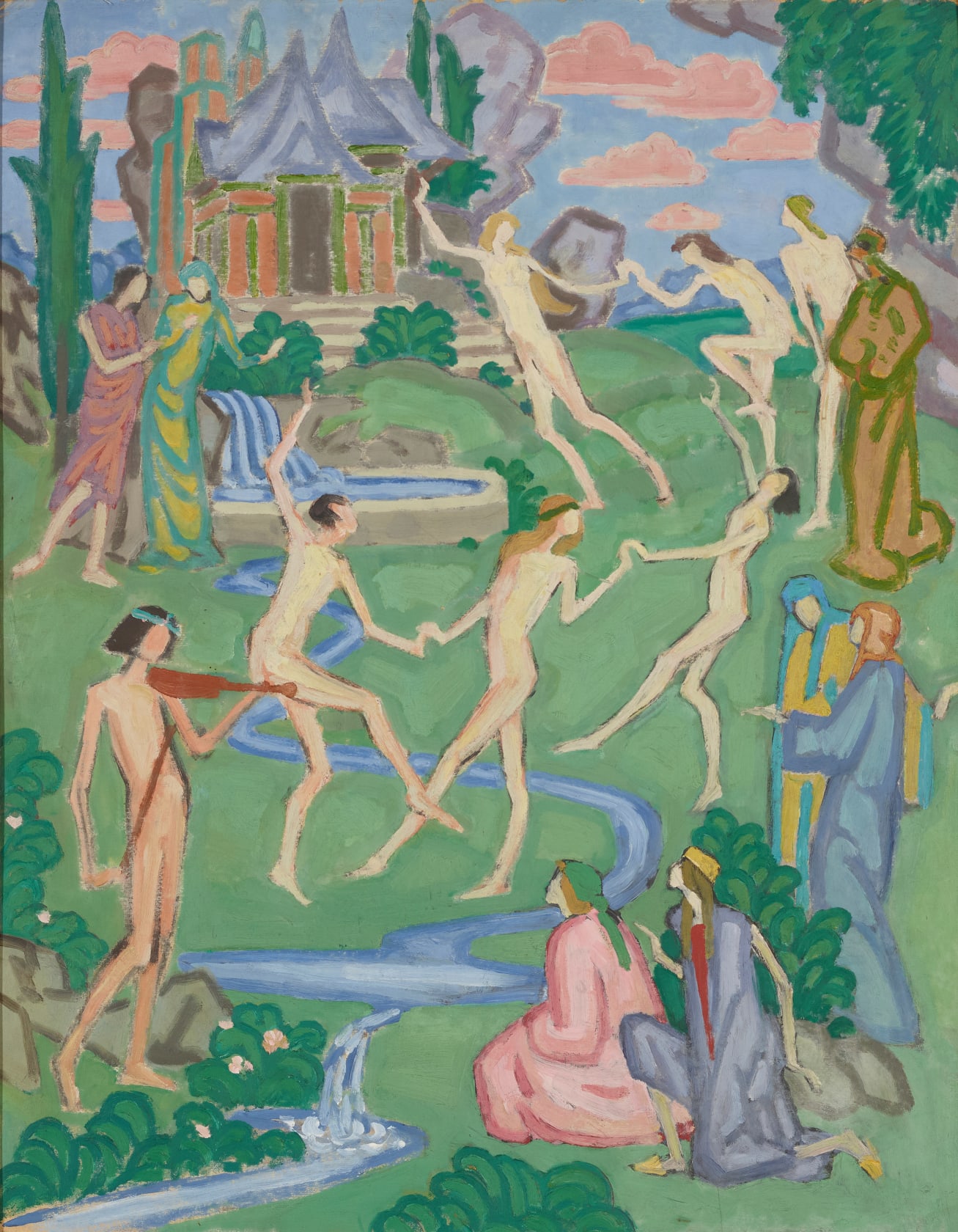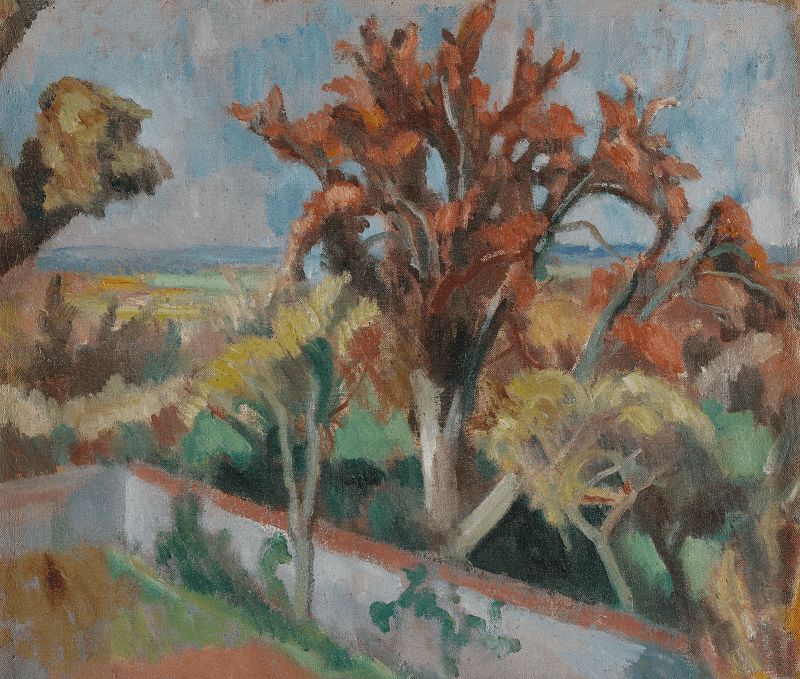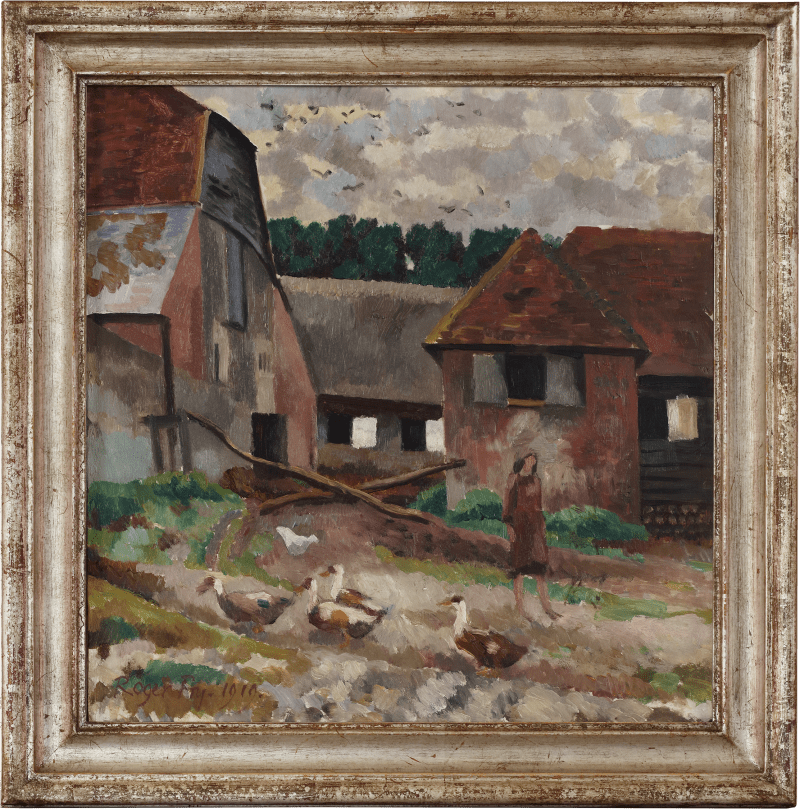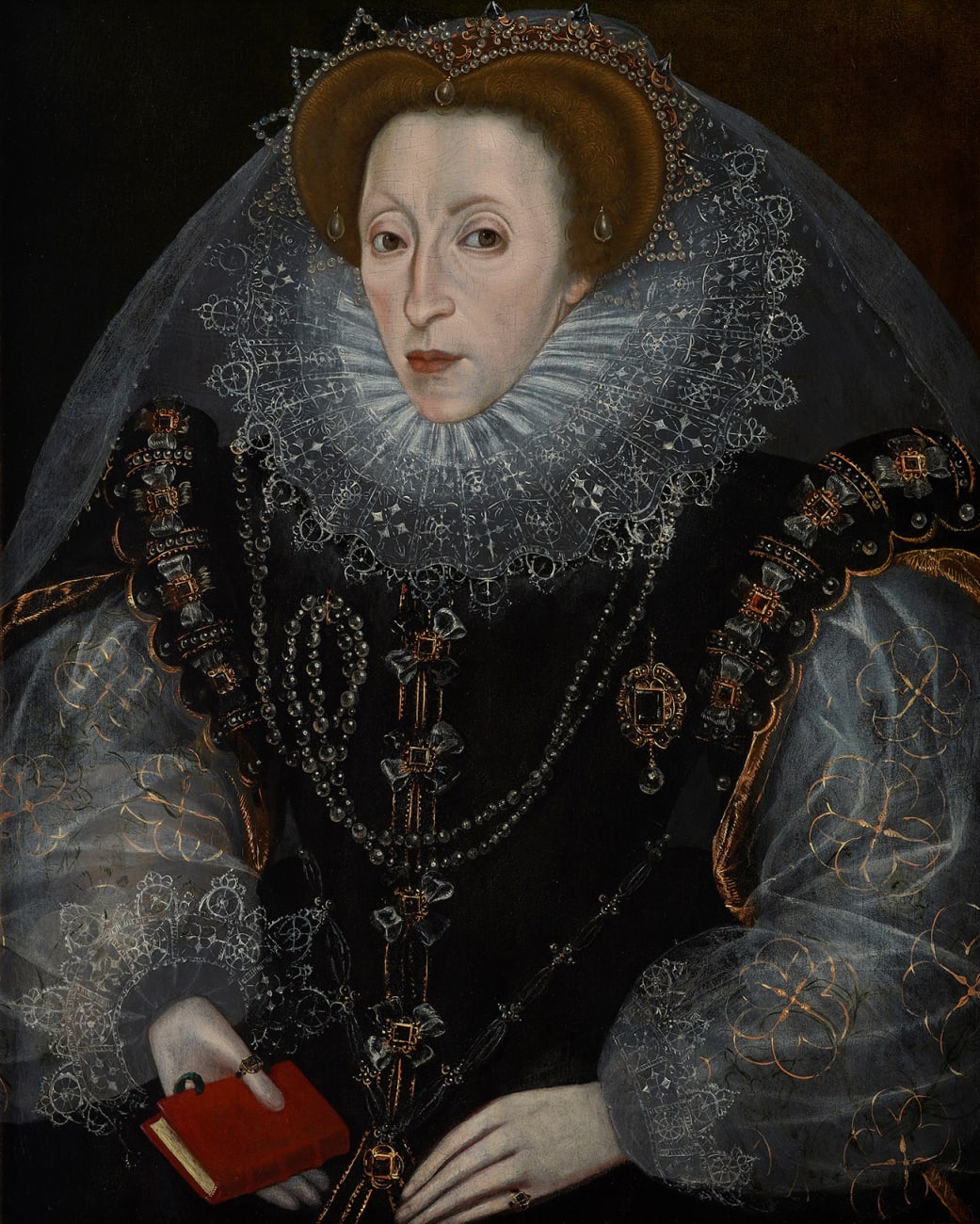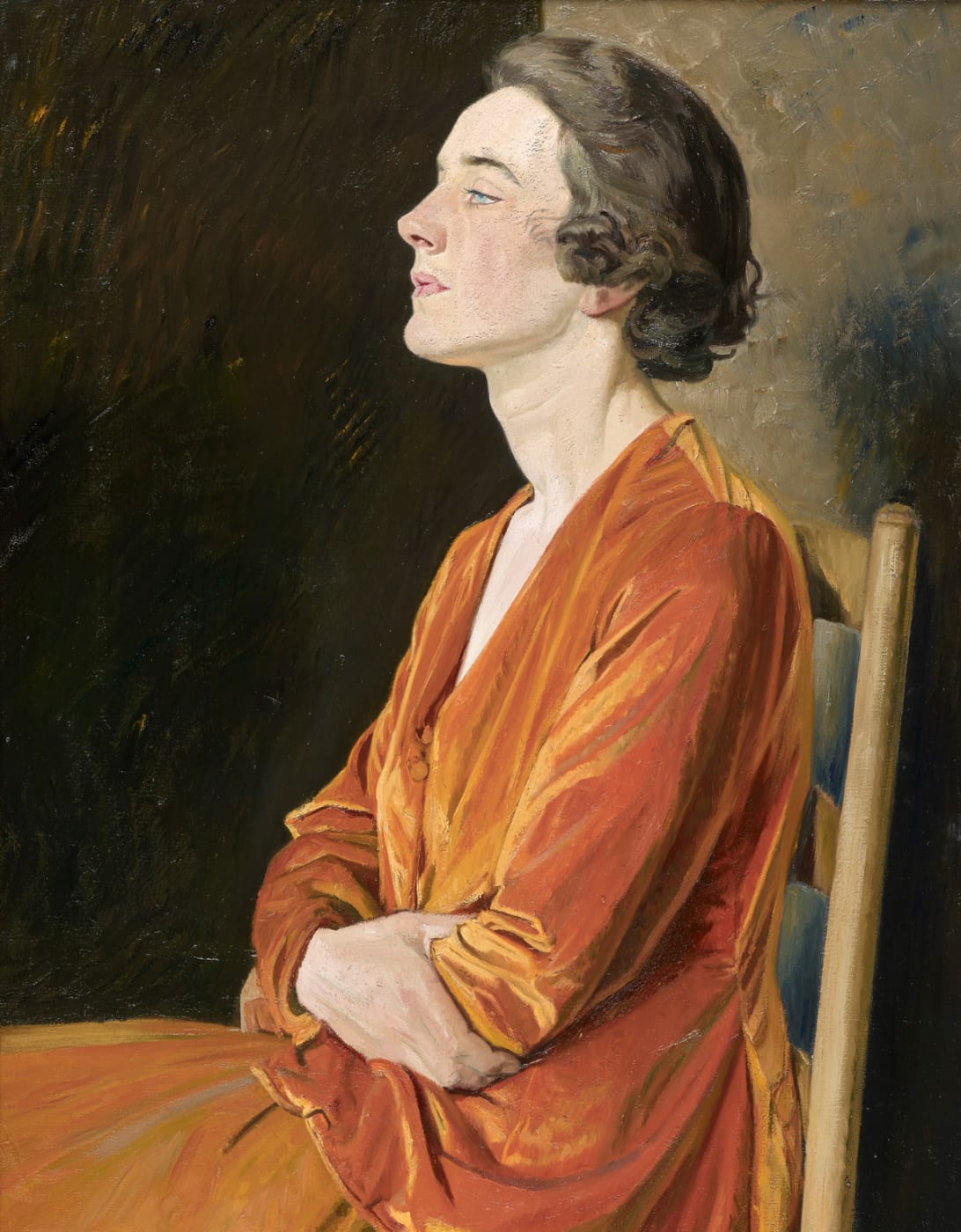Dancers is an early modernist painting made at the advent of Post-Impressionist art in Britain. Roger Fry distinguished himself as both an intellectual and a painter, and these two activities were inseparably connected throughout his life. This work was painted around the time that Fry curated the fêted exhibition Manet and the Post-Impressionists, held at the Grafton Galleries in London, which provoked a public outcry and created a new taxonomy of modernist painting. Having previously worked in a temperate, well-constructed style of naturalistic painting informed by his deep familiarity with old master painting from Giotto to Rembrandt, Fry’s style began to change following his first exposure to Cezanne in 1906. His painting Dancers uses an eclectic mixture of avant-garde tropes—in its radical simplification of detail, its irreverent subject-matter, its flamboyant palette of pure colour—and the traditions of history painting – in its multi-figure composition, its historicist costumes, its allusions to myth or ritual.
Dancers may be construed as Fry’s...
Dancers is an early modernist painting made at the advent of Post-Impressionist art in Britain. Roger Fry distinguished himself as both an intellectual and a painter, and these two activities were inseparably connected throughout his life. This work was painted around the time that Fry curated the fêted exhibition Manet and the Post-Impressionists, held at the Grafton Galleries in London, which provoked a public outcry and created a new taxonomy of modernist painting. Having previously worked in a temperate, well-constructed style of naturalistic painting informed by his deep familiarity with old master painting from Giotto to Rembrandt, Fry’s style began to change following his first exposure to Cezanne in 1906. His painting Dancers uses an eclectic mixture of avant-garde tropes—in its radical simplification of detail, its irreverent subject-matter, its flamboyant palette of pure colour—and the traditions of history painting – in its multi-figure composition, its historicist costumes, its allusions to myth or ritual.
Dancers may be construed as Fry’s attempt to develop a new form of painting inspired partly by the art of Henri Matisse. Matisse’s masterpiece La Danse was exhibited at the Salon d’Automne in Paris in autumn 1910, shortly before Manet and the Post-Impressionists opened in November that year. Fry later included it in the Second Post-Impressionist Exhibition, a sequel that was also held at the Grafton Galleries.[1] The interlocking chains of naked, sensual figures have an immediate, superficial similarity to the subject of Fry’s painting. Fry’s admiration for Matisse is evident from his selection for the two Post-Impressionist exhibitions: two landscape paintings, nine sculptures and twelve drawings by Matisse were included in Manet and the Post-Impressionists, some of which were borrowed from the artist directly; as many as forty works by Matisse were included in the Second Post-Impressionist Exhibition. The execution of Dancers also strongly suggests an interpretation of Matisse. The paint was applied with flat touches in sharply defined, contrasting areas of colour. The emphasis was upon producing a decorative, uniform surface, rather than the modelling of figures or painterly structure. Fry wrote of Matisse in the catalogue for the Second Post Impressionist Exhibition: ‘In opposition to Picasso, who is pre-eminently plastic, Matisse aims at convincing us of the reality of his forms by the continuity and flow of rhythmic line, by the logic of his space relations, and, above all, by an entirely new use of colour.’[2] Fry’s analysis of Matisse’s work and his own painting experiment in Dancers suggest a conscious effort to develop his own original, modernist style with Matisse as a point of departure.
The imagery of Dancers is idyllic, rural and semi-classical. No definite iconography has yet been identified for the painting, but the interlocking chains of naked, dancing figures are redolent of Bacchanalian revels. Several groups of clothed figures appear to watch admiringly. In the foreground there is a naked musician holding a bowed instrument similar in appearance to a violin. The naked figures adhere to a uniformly mannerist type; their limbs are thin and elongated. The scenery is bucolic and verdant. A flat plane of green is punctuated by a stream, which twists through the length of the picture from a pool down to a brook in the foreground. (Fry included five of his own paintings in the Second Post-Impressionist Exhibition, amongst them a painting titled ‘The Cascade’ (no. 82), a hitherto unidentified work, and Dancers might possibly be the self same work.)[3] A cypress tree breaks the horizon at the upper left-hand corner and indicates a setting in the Mediterranean climate of southern Europe. The imagery touches upon an undefined mixture of cultural allusions, including classical antiquity, orientalism (the confused architecture of the temple at upper left, for example), and perhaps a recent trend for gypsy culture encouraged by Augustus John amongst others. The kneeling figure in the foreground wears a green bandana headdress and pink robes that are familiar from contemporaneous paintings by John.
This painting was first owned by the charismatic arts patron Lady Ottoline Morrell. She was initiated into avant-garde painting by Augustus John, whose work she bought and with whom she had an unusual romance. She first met Roger Fry in 1909. Writing that year to the keeper of the Tate Gallery, D. S. MacColl, Fry said: ‘She has been very good to me and has a real feeling for art.’[4] They were both central to the establishment of the Contemporary Art Society in 1910, and Lady Ottoline acted as the Society’s buyer in its early years. In February 1911, Fry painted Lady Ottoline’s portrait at Peppard, her house near Henley-on Thames. Their friendship intensified and, when Fry paid a visit to her home in Bedford Square in March 1911, they had a sexual encounter. Fry wrote to her afterwards: ‘I’m still all amazed and wondering … can’t begin to think—I can only know how beautiful it was of you, how splendid—[…] it was altogether beautiful and right.’[5] By May that year, Fry had taken against Lady Ottoline and a lasting enmity was established between them; he believed that she had spread a rumour that he was in love with her.[6] It seems likely that Fry’s painting Dancers was purchased by Lady Ottoline sometime before their quarrel in May 1911. It remained in her possession, part of a significant collection of modern British pictures, and was sold by her descendants through Sotheby’s in 1980.[7]
[1] London, Grafton Galleries, Second Post-Impressionist Exhibition, 5 Oct. – 31 Dec. 1912, cat. no. 185.
[2] Roger Fry, ‘The French Group’, in Second Post-Impressionist Exhibition, exh. cat., Grafton Galleries, 1912, p. 27.
[3] Another painting, believed to be a work of 1912, today known as River with Poplars (Tate), also includes a significant watery element in its composition.
[4] Letter from Roger Fry to D. S. MacColl, March 1909, quoted in Sandra Jobson Darroch, Ottoline: The Life of Lady Ottoline Morrell, Chatto & Windus, 1976, p. 73.
[5] Letter from Roger Fry to Lady Ottoline Morrell, undated, Harry Ransom Center, Texas, quoted in ibid., p. 99.
[6] Ibid., pp. 106–108.
[7] This painting was not included in the posthumous exhibition of Lady Ottoline’s collection held at the Leicester Galleries in 1956. London, Leicester Galleries, Pictures from Garsington, March 1956.
